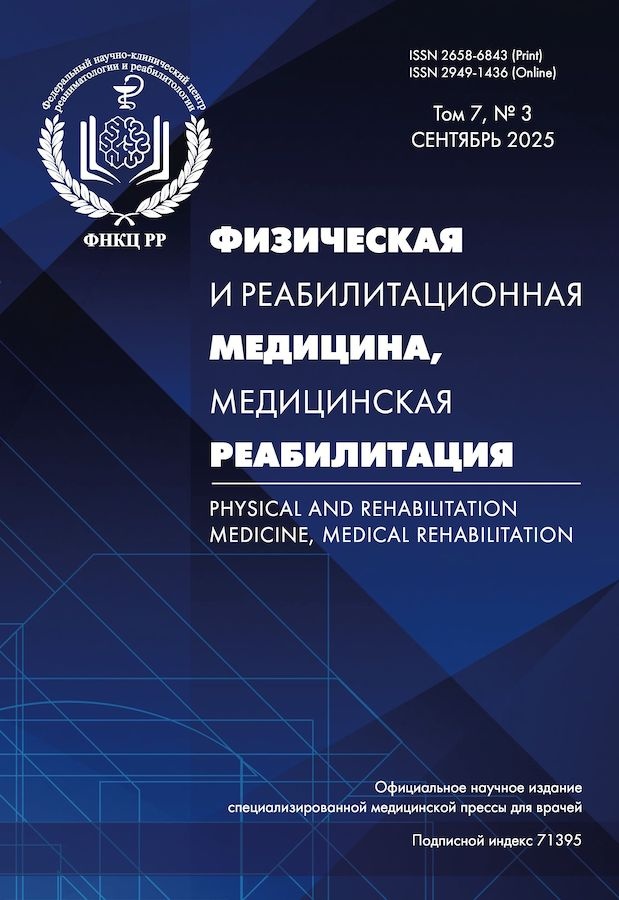Methods of Evaluation of Tolerance yo Physical Activity Based on Six-Minute Walking Test During Outpatient Rehabilitation of Patients with Ischemic Heart Disease
- Authors: Mikhailovskaya T.V.1, Mishina I.E.1, Nazarova O.A.1, Dovgalyuk Y.V.1, Chistyakova J.V.1
-
Affiliations:
- Ivanovo State Medical Academy
- Issue: Vol 3, No 1 (2021)
- Pages: 4-10
- Section: ORIGINAL STUDY ARTICLE
- URL: https://journal-vniispk.ru/2658-6843/article/view/64360
- DOI: https://doi.org/10.36425/rehab64360
- ID: 64360
Cite item
Full Text
Abstract
Background. Even though the six-minute walking test is a simple and widely available tool for the evaluation of the functional capacity of cardiac patients, its interpretation is associated with some difficulties and contradictions. Aims: To evaluate the dynamics of tolerance to physical activity during outpatient rehabilitation of patients with ischemic heart disease using predicted values of distance in the six-minute walking test. Materials and methods. 97 patients (70 men and 27 women, average age 59.6 [50; 60] years) after acute coronary syndrome and after myocardial revascularization were included. The six-minute walking test was performed at the beginning of the 3-weeks stage of cardiac rehabilitation and before the patients’ discharge. The results of the test were reported as an absolute value, a change in absolute value, and the percentage of predicted values, estimated with the reference equation by Enright and colleagues. Results. The absolute value of distance in the six-minute walking test was increased significantly from 418 [385; 465] m to 485 [440; 525] m (p <0.001). The number of patients with a distance less than 300 m was decreased significantly (12 patients, 12% vs 2 patients, 2%, p <0.001). In most patients, the absolute increase in distance was 30 m and more (81 people, 84%). After comparing the perceived data with the calculated predicted values, it was revealed that the distance raised from 79 [71; 82]% to 92 [88; 96]% of the predicted values. And 56 patients (58%) had a distance equal to 90% or more from its predicted value. Conclusions. During the third stage of cardiac rehabilitation the significant increase of the absolute value of the six-minute walking test, the growth of the percentage of predicted values, and the decrease of patients with a distance less than 300 m were found. All these estimation methods may be used to demonstrate and prove favourable changes of tolerance to physical activity in patients with ischemic heart disease.
Full Text
##article.viewOnOriginalSite##About the authors
Tatyana V. Mikhailovskaya
Ivanovo State Medical Academy
Author for correspondence.
Email: tanyadoc8484@mail.ru
ORCID iD: 0000-0002-4329-098X
SPIN-code: 7209-0144
Cand. Sci. (Med.), Associate Professor
Russian Federation, IvanovoIrina E. Mishina
Ivanovo State Medical Academy
Email: mishina-irina@mail.ru
ORCID iD: 0000-0002-7659-8008
SPIN-code: 2549-1182
Dr. Sci. (Med.), Professor
Russian Federation, IvanovoOlga A. Nazarova
Ivanovo State Medical Academy
Email: oanazarova@mail.ru
ORCID iD: 0000-0002-6920-0874
SPIN-code: 6135-6646
Dr. Sci. (Med.), Professor
Russian Federation, IvanovoYuri V. Dovgalyuk
Ivanovo State Medical Academy
Email: yuriy.d@mail.ru
ORCID iD: 0000-0001-9099-400X
SPIN-code: 1148-7850
Cand. Sci. (Med.), Associate Professor
Russian Federation, IvanovoJulia V. Chistyakova
Ivanovo State Medical Academy
Email: chud.iv@mail.ru
ORCID iD: 0000-0002-9013-5763
SPIN-code: 1193-2864
Cand. Sci. (Med.), Associate Professor
Russian Federation, IvanovoReferences
- American Thoracic Society Committee on Proficiency Standards for Clinical Pulmonary Function Laboratories. ATS statement: guidelines for the six-minute walk test. Am J Respir Crit Care Med. 2002;166(1):111–117. doi: 10.1164/ajrccm.166.1.at1102
- Holland AE, Spruit MA, Troosters T, et al. An official European respiratory society/American thoracic society technical standard: field walking tests in chronic respiratory disease. Eur Respir J. 2014;44(6):1428–1446. doi: 10.1183/09031936.00150314
- Мишина И.Е., Сарана А.М., Михайловская Т.В., Иванова Г.Е. Принципы назначения аэробных физических тренировок при проведении амбулаторной кардиореабилитации // Вестник восстановительной медицины. 2020. Т. 97, № 3. С. 83–95. [Mishina IE, Sarana AM, Mikhailovskaya TV, Ivanova GE. Principles of the appointment of aerobic physical training during outpatient cardiorehabilitation. Vestnik vosstanovitel’noi meditsiny. 2020;97(3):83–95. (In Russ).] doi: 10.38025/2078-1962-2020-97-3-83-95
- Довгалюк Ю.В., Чистякова Ю.В., Воробьёва Т.В., Мишина И.Е. Динамика толерантности к физической нагрузке с учетом гендерных особенностей у больных, перенесших острый коронарный синдром, в процессе амбулаторного этапа реабилитации // Физическая и реабилитационная медицина, медицинская реабилитация. 2020. Т. 2, № 2. С. 126–132. [Dovgalyuk YV, Chistyakova YV, Vorobyova TV, Mishina IV. Gender-related dynamics of exercise tolerance in patients with acute coronary syndrome undergoing the outpatient phase of rehabilitation. Physical and Rehabilitation Medicine, Medical Rehabilitation. 2020;2(2):126–132. (In Russ).] doi: https://doi.org/10.36425/rehab26343
- Иванова Г.Е., Мельникова Е.В., Белкин А.А. и др. Как организовать медицинскую реабилитацию? // Вестник восстановительной медицины. 2018. № 2. С. 2–12. [Ivanova GE, Melnikova EV, Belkin AA, et al. How to organize medical rehabilitation? Vestnik vosstanovitel’noi meditsiny. 2018;(2):2–12. (In Russ).]
- Giannitsi S, Bougiakli M, Bechlioulis A, et al. 6-minute walking test: a useful tool in the management of heart failure patients. Ther Adv in Cardiovasc Dis. 2019;13: 1753944719870084. doi: 10.1177/1753944719870084
- Баклушин А.Е., Мишина И.Е., Романчук С.В. и др. Содержание и первые результаты реабилитации кардиологических больных в клинике // Вестник восстановительной медицины. 2014. № 6. С. 43–46. [Baklushin AE, Mishina IE, Romanchuk SV, et al. Content and first results of rehabilitation of cardiac patients in the clinic Vestnik vosstanovitel’noi meditsiny. 2014;(6):43–46. (In Russ).]
- Enright PL, Sherrill DL. Reference equations for the six-minute walk in healthy adults. Am J Respir Crit Care Med. 1998; 158(5 Pt 1):1384–1387. doi: 10.1164/ajrccm.158.5.9710086
- Beriault K, Carpentier AC, Gagnon C, et al. Reproducibility of the 6-minute walk test in obese adults. Int J Sports Med. 2009;30:725–727. doi: 10.1055/s-0029-1231043
- Arslan S, Erol MK, Gundogdu F, et al. Prognostic value of 6-minute walk test in stable outpatients with heart failure. Tex Heart Inst J. 2007;34:166–169.
- Curtis JP, Rathore SS, Wang Y, et al. The association of 6-minute walk performance and outcomes in stable outpatients with heart failure. J Card Fail. 2004;10:9–14.
- Ferreira JP, Duarte K, Graves TL, et al. Natriuretic peptides, 6-min walk test, and quality of life questionnaires as clinically meaningful endpoints in HF trials. J Am Coll Cardiol. 2016;68(24):2690–2707. doi: 10.1016/j.jacc.2016.09.936
- Ciani O, Piepoli M, Smart N, et al. Validation of exercise capacity as a surrogate endpoint in exercise-based rehabilitation for heart failure: a meta-analysis of randomized controlled trials. JACC Heart Fail. 2018;6(7):596–604. doi: 10.1016/j.jchf.2018.03.017
- Enright PL. The six-minute walk test. Respir Care. 2003; 48(8):783–785.
- Troosters T, Gosselink R, Decramer M. Six minute walking distance in healthy elderly subjects. Eur Respir J. 1999; 14(2):270–274. doi: 10.1034/j.1399-3003.1999.14b06.x
- Gibbons WJ, Fruchter N, Sloan S, et al. Reference values for a multiple repetition 6-minute walk test in healthy adults older than 20 years. J Cardiopulm Rehabil. 2001;21(2): 87–93. doi: 10.1097/00008483-200103000-00005
- Juocevicius A, Oral A, Lukmann A, et al. Evidence-based position paper on Physical and Rehabilitation Medicine (PRM) professional practice for people with cardiovascular conditions. The European PRM position (UEMS PRM Section). Eur J Phys Rehabil Med. 2018;54(4):634–643. doi: 10.23736/S1973- 9087.18.05310-8
Supplementary files








